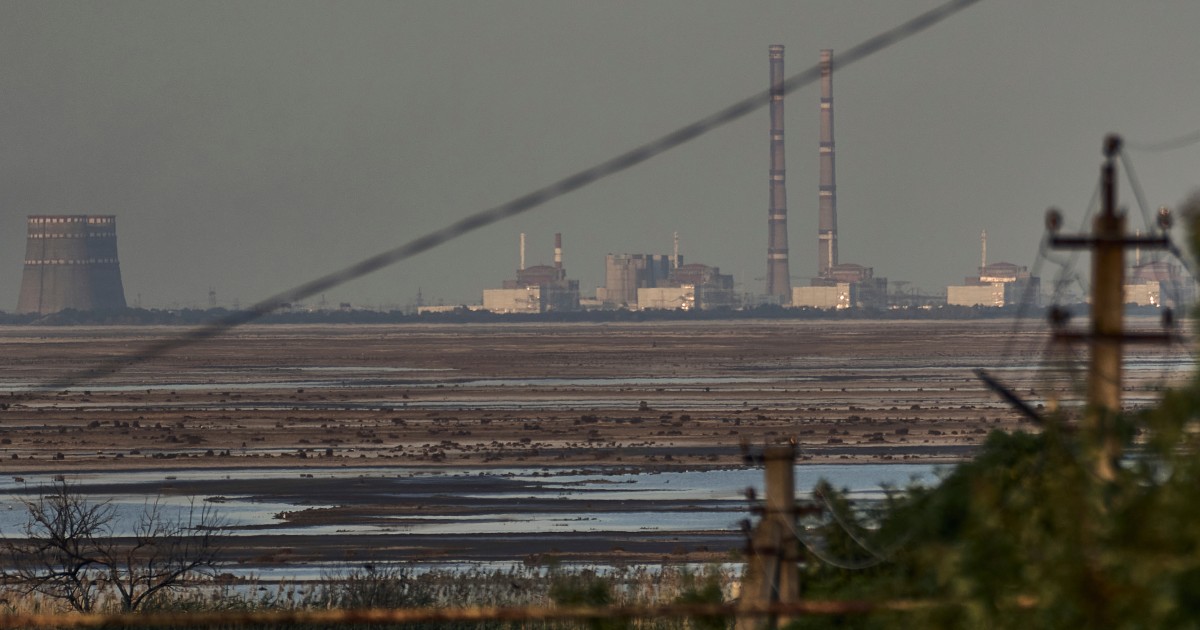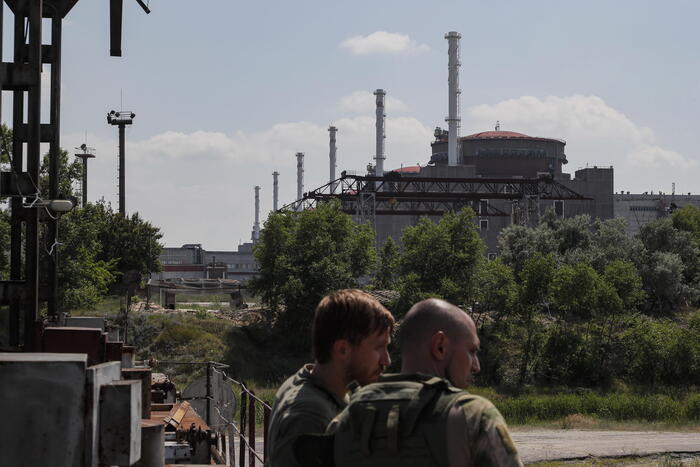The blowing up of the Kakhovka dam on the Dnieper, possibly in response to Russia's response to the Ukrainian counteroffensive, is fueling concerns about an accident at the Zaporizhzhia nuclear power plant.
A detailed classification of how great the dangers are for the nuclear power plant and what could happen in the event of a disaster.
This analysis is IPPEN. MEDIA in the course of a cooperation with the Europe.Table Professional Briefing – it was first published by Europe.Table on 7 June 2023.
What is the situation at the Zaporizhzhia nuclear complex after the blowing up of the Kakhovka dam?
The Ukrainian Zaporizhzhia nuclear power plant has been occupied by Russian troops almost since the beginning of the Ukraine war, and technical supplies continue to be provided by Ukrainian personnel. After the blowing up of the Kakhovka dam on the Dnieper on Tuesday morning, about 150 kilometers downstream, the risk of accidents is increasing. The water from the reservoir is used to cool the reactors and the generators that secure the power supply at the power plant. According to Ukrainian estimates, the cooling water in the reservoir of the nuclear power plant will last for a few weeks. The International Atomic Energy Agency (IAEA) expressed concern about the falling water level of the reservoir. She is monitoring the situation very intensively, but for the time being there is no acute danger to the nuclear power plant.
Why is Russia occupying the nuclear power plant?
The Zaporizhzhia nuclear power plant is a bargaining chip of the Moscow occupiers. President Vladimir Putin recently made this clear when he mentioned the power plant in passing after the drone attacks on Moscow – an implicit threat. The military occupation of a nuclear power plant is new, there has never been anything like it before. The United Nations Atomic Energy Agency (IAEA) has no mechanism to deal with such a situation. Russia has controlled the area around the nuclear power plant since February 2022, and Ukrainian personnel continue to ensure the operation of the plant.
Newsletter from Table.Media
Get 30 days of free access to further exclusive information from the Table.Media Professional Briefings – the decisive factor for the decision-makers in business, science, politics, administration and NGOs.
Why is Zaporizhzhia so important?
The nuclear facility on the banks of the Dnieper River is the largest nuclear power plant in Europe. Six reactor units with a total capacity of 5700 megawatts supply about half of Ukraine's electricity in peacetime. Currently, all six are shut down, but some still need to be refrigerated. The power supply for this is secured via only one external line, which, however, has already been cut seven times since the beginning of the war. In the nacelles of units 1, 2 and 4, the Russian occupying army stores military equipment and ammunition. In total, there are 15 active reactor units in the country. In addition, there is the area around the Chernobyl nuclear power plant on the border with Belarus, which exploded in 1986 due to an operating error.
How endangered is the nuclear facility?
The Director General of the IAEA, Rafael Grossi, expressed "extreme concern about the very real risks to nuclear safety at the plant" a month ago. The situation will be "unpredictable and potentially dangerous". IAEA inspectors at the site confirm regular artillery shelling around the power plant. They also noted that the families of the operating crews who were forced to work at the nuclear power plant by the Russian occupation forces were taken away from the nearby town of Enerhodar. More often, shells have hit near or on the site of the nuclear complex. The reactors and their containments have so far been spared. In March 2022, during the occupation by Russian troops, there was active fighting on the site around the kilns, an office building caught fire.
0
Also Read
"Putin's decline": President shies away from citizens' questions on state TV
READ
Tank attacks launched: Ukrainian offensive breaks through Putin's front line
READ
New "window accident" in Russia: Next top official falls to his death
READ
Putin 'under greater pressure than ever': Russia's elite no longer believes in their president
READ
Russia rejoices: But has Ukraine even launched the counteroffensive?
READMone area
How vulnerable is the plant?
Nuclear facilities are vulnerable to military force. They depend on the fact that technology and supplies function properly, that operating crews can work unhindered and concentrated, that regular checks and security checks are carried out, that there is free exchange of data. None of this has been guaranteed in Zaporizhzhia for over a year. In response to the Russian army's takeover of Zaporizhzhia, the IAEA has defined seven criteria for the safe operation of nuclear power plants: these include physical protection of facilities, secure power and data supply, free access for personnel, and functioning monitoring systems. This is not currently being implemented.
What can happen?
In the worst case, three horror scenarios in particular would be conceivable:
- A direct bombardment of the reactor blocks with heavy weapons, a crash of an airplane or a serious explosion, with the Russian military technology stationed on the site, destroys the outer reactor shell (the containment). If the reactor pressure vessel inside is destroyed during or after, the atomic core is exposed, resulting in a massive leakage of radioactive particles and strong radiation of the plant.
- The power supply to the reactors is cut off. This could also happen if the Russian occupiers want to disconnect the nuclear power plant from the Ukrainian grid and connect it to the power grid of the Russian-occupied territories. In this case, if the emergency generators fail or are destroyed, the reactors could no longer be cooled. This would lead to a meltdown in relatively intact containments and pressure vessels – as happened in Fukushima in 2011. Little radioactivity escapes over a wide area, but the facilities are destroyed and heavily irradiated. In the event that radiating cargo enters the adjacent Dnieper River, the region's water supply could be affected. According to the Federal Office for Radiation Protection (BfS), the contamination of groundwater by the radionuclide strontium-90 (Sr-90) "could pose a problem in the long term".
- Military shelling or an accident involving military equipment on the ground destroys one or more containers for nuclear waste stored next to the reactors. The "spent fuel", some of which are highly radiating, are released into the atmosphere, and depending on the extent and radioactivity, the site is irradiated.
How realistic are these fears?
The containment and containers for the nuclear waste are strongly secured. Even direct artillery fire would hardly destroy the containment immediately and directly, experts say. The garbage containers "HI-STORM FW" from the US company Holtec are also massive, they have walls made of steel and 75 centimeters of concrete. They are also used in the U.S. as long-term containers for nuclear waste and, according to the manufacturer, protect fuel rods from "natural and man-made projectiles, including the impact of an F-16 fighter jet." According to BfS information, even if damage were to occur to the waste containers, the damage would be "limited locally or regionally at most" because the radioactivity would be up to 100 times lower than in the reactor core.
Is there a threat of a second Chernobyl?
Even a leak of radioactivity would hardly have the effect of the Chernobyl accident, experts say: In the 1986 meltdown, the containment was blown up by an explosion of the reactor core, which threw its highly radioactive contents and the "chimney effect" of the fire in the reactor into the atmosphere. It was there that the radioactive "cloud" formed, which passed over Ukraine, Belarus, Northern and Central Europe. In Zaporizhzhia, experts do not expect such a scenario. In addition, the wind in the area usually comes from the west. According to BfS calculations, this would carry the radioactive cargo in the direction of Russia and currently Russian-occupied territories.
What is the legal situation?
Russia is violating international law and IAEA rules by making the facility a military target, capturing it and forcing the operating crews to continue working. An additional protocol to the Geneva Conventions expressly places facilities such as nuclear power plants or dams under special protection in conflicts. IAEA rules also require that nuclear facilities must not be military targets.
What does the IAEA say?
The head of the IAEA, Grossi, has repeatedly expressed great concern and called for the situation around Zaporizhzhia to be eased. However, Grossi has not been able to push through his 7-point plan despite negotiations and visits to Kiev and Moscow. Since summer 2022, changing teams of IAEA observers have been stationed at the facility. The agency has condemned Russia's takeover of the power plant and called on Russians to withdraw from Zaporizhzhia.
However, the IAEA itself has also come under criticism. Because Russia is a dominant member in this UN organization, a former representative of the Russian state-owned company Rosatom is IAEA Director General for Atomic Energy. A debate on the role of the state-owned company Rosatom in the takeover and operation of Zaporizhzhia has not yet taken place in the IAEA. The IAEA supports the expansion of nuclear technology into new countries. In doing so, the agency supports Rosatom's business model, which builds and operates nuclear facilities around the world and thus dominates the market.
How important is Rosatom for Europe?
The EU's economic sanctions against Russia exclude the nuclear sector. Five EU countries and five NATO members are dependent on Russian technology for their electricity supply: Finland stopped the construction of a new reactor by a Russian consortium after the start of the war. But countries such as Bulgaria, Hungary, Slovakia and the Czech Republic sometimes produce up to half of their electricity with Russian nuclear technology and are dependent on materials and supplies. The new large Akkuyu nuclear power plant in Turkey, which has just been officially opened, is also being built and operated by Rosatom. (By Viktor Funk and Bernhard Pötter)













